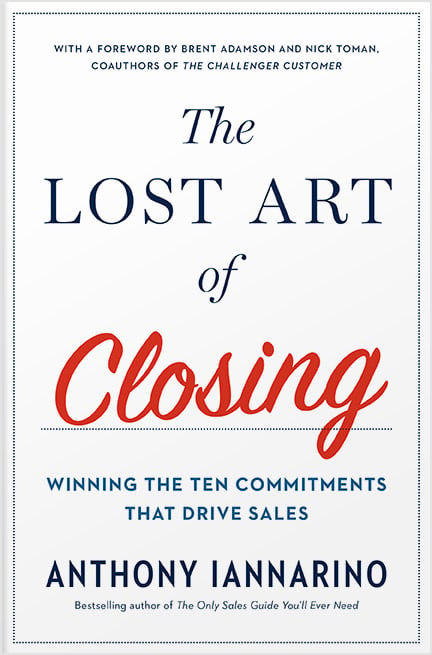Both you and your prospective client have something at risk as you enter into the sales conversation. It can feel as if you, the salesperson, have much at risk at each stage of the process. The truth is that your contacts have as much—and sometimes more—at risk than you do.
The framework below is from The Lost Art of Closing: Winning the 10 Commitments That Drive Sales. It is a methodology for managing the collective commitments and conversations we ask our clients to make in consultative, B2B sales where a modern sales approach is necessary and improves your odds of creating new opportunities and winning big deals.No more pushy sales tactics. The Lost Art of Closing shows you how to proactively lead your customer and close your sales. 
Time
What’s at stake for you is a chance to create enough value to earn the right for another meeting, or to fail to provide the experience and end up without a next meeting.
What’s at stake for your prospective client is the opportunity to learn something that will benefit them, or to have wasted their time with someone unprepared to use their time wisely.
Exploration
You have a lot at stake in exploration meetings, an early sales conversation about what could or should be compelling a company to do something different, providing a possibility to do something better. Doing well here can be the beginning stages of creating an opportunity, or a short conversation that goes nowhere.
Your contact has a lot at stake too. They have a chance to imagine how and what might be improved, and how it would improve their position, a conversation that moves them forward. They also risk another salesperson asking them what’s keeping them up at night.
Change
There is a possibility that your potential client agrees to move forward with a decision to engage in the process of seriously considering doing something different, making a significant change. What is also at risk here is that you haven’t properly laid the necessary groundwork to establish yourself as the right person with whom to pursue a new initiative.
For your dream client, they have a chance to generate massively better results, achieving something far above what they are capable of now, with your help, of course. What is also at stake for them is making a mistake that would fail them, embarrass them, and cost them time and money and their place in the pecking order.
Collaborate
What is at stake here is engagement in a process that ensures that the solution is something that is going to be customized for the client individually, increasing the odds that they support it, and that it will work for them. The other idea you must consider is that the solution is yours alone and that it doesn’t provide your contacts with something to which they can say yes.
The people with whom you collaborate get to participate in their future, making the adjustments they believe will help them get the results they need—based on their greater knowledge of what will work best for them, even if you have to help shape it with your experience. They also risk changing so much of what is essential that they risk a lesser result than was possible.
Consensus
What is at stake here is nothing less than the life of your deal and your client’s better results. Without the support necessary, initiatives die an early death. Your chance to build consensus, once gone, is incredibly difficult to regain. You will have either built support or not.
Your clients often believe they risk their initiative by bringing people into the conversation when the opposite is true. Even though there is a risk of bringing in dissenters and cynics, the real loss comes when they have the moral high ground and the ability to say no because they were left out.
Investments
For you, what is at stake is your client’s agreement that the investment you are asking them to make is in line with the outcomes you are going to deliver. You must not avoid this conversation, fearing the possibility that they will object to the price, and forcing you to justify the delta between your price and what they are paying now—or your competitor’s price.
Your contacts have a lot riding on the investment, too. If they invest and don’t get the results, they will have lost time and spent more money than they needed to. If they make the appropriate investment with the right partner, they gain the better results they need. If they underinvest, they may have the worst of all outcomes, an even worse outcome than the current state when they started down this path.
Review
By asking your client to review your solution before you give them a presentation and final proposal, you risk only the fact that you may be wrong, the reason you are asking them to review it in the first place. Studying the solution gives you the chance to make sure it is perfect. Not reviewing and revising it means putting your deal at risk.
The contacts risk the time it takes to confirm your solution is perfect. They cannot be harmed by making sure it is exactly what they want before they buy. Unless time is of the essence and an opportunity may be lost, there is little to which they might say no.
Resolve Concerns
Much is at stake when your dream client tells you they are going to talk with their team about your proposal and solution. Once you hand over the plan, a conversation about that proposal that doesn’t include you often means questions go unanswered and concerns go unaddressed. You put your deal and your client’s better results in jeopardy by not being a part of that conversation, during if possible, afterward, at worst.
The people with whom you have been working through this process chance bringing up concerns in which they cannot resolve themselves. This process can cause them to surface new concerns that cause some people to withdraw their support, ending their initiative, and losing an opportunity to transform their results.
Decide
At some point, you have to ask your client to sign a contract and allow you to begin executing the solution you built together. Selling is a game in which the rewards only accrue to the person who wins, unlike, say, professional sports where players are paid whether they win or lose. Everything is on the line here, but having made it this deep into the sales conversation, a yes should be easy.
Your client’s decision is binary; it’s a yes or a no. Their decision is going to be proven, right or wrong. The solution is going to improve their results, or it isn’t, with positive or negative consequences.

Get the Free eBook!
Learn how to sell without a sales manager. Download my free eBook!
You need to make sales. You need help now. We’ve got you covered. This eBook will help you Seize Your Sales Destiny, with or without a manager.
Download Now







.jpg?width=768&height=994&name=salescall-planner-ebook-v3-1-cover%20(1).jpg)


